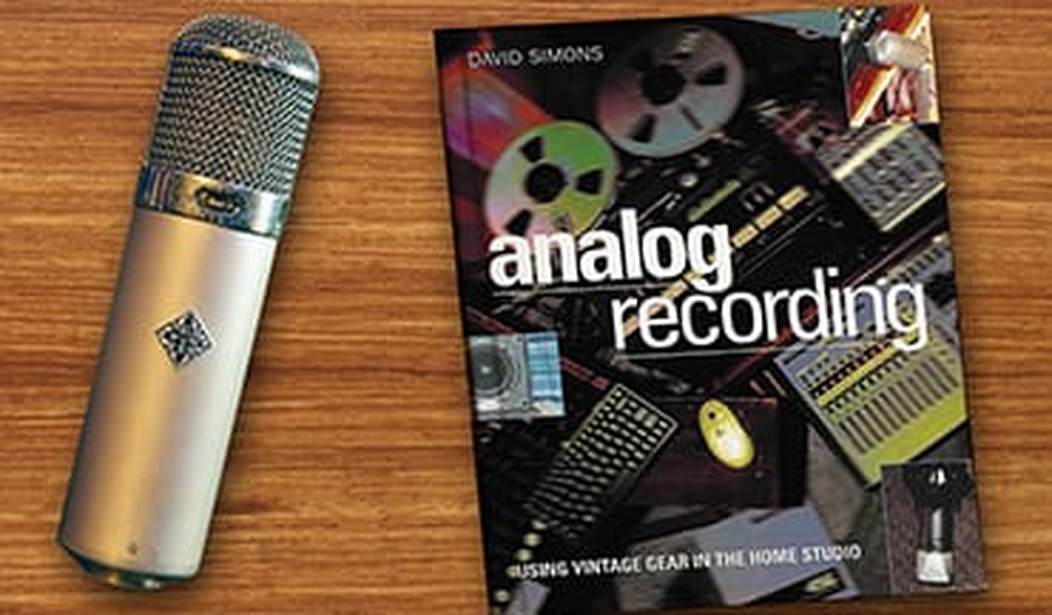Written in 2006, David Simons’ book, Analog Recording, Using Analog Gear in Today’s Home Studio is an early look at where home recording began to head in the 21st century. In 1979, Tascam introduced the first cassette-based four-track recorder, bringing affordable home-based multi-track recording to musicians. Around that same time, Roland and Linn were introducing the first programmable drum machines. Both of these were initially pretty-crude sounding technologies, but at least, a musician could now record a demo of his song at home, without burning studio fees.
Flash-forward to the mid-2000s, and the digital revolution has greatly transformed home-recording. PCs allow for near-unlimited tracks, drum loops of some of the world’s best drummers are available for $50 or less. Software synthesizers such as Propellerhead’s Reason have an orchestra’s worth of sampled instruments in them. Guitar modeling allows any player to sound like he’s got 100 watts of Marshall stack behind him, without worrying about his neighbors calling the police at 2:00 in the morning because of the volume. Plug-in recreations of reverbs, delays, chorus and flanging are flexible, often highly serviceable recreations of popular pro studio effects.
But those involved in recording at home faced the same dilemma that professional studios wrestled with in the 1980s and ’90s: digital PC-based recording offers incredible editing flexibility, but pro studios missed the warmth of the analog days. All those vacuum tube-powered condenser mics, pre-amps, compressors, and the tape itself added a warmth to recording, and a human factor, that was often missing in the hard-quantized digital world. Or as “Yep,” the recording engineer/producer who wrote the bulk of the posts of the legendary “Why Do Your Recordings Sound Like Ass” thread at the Cockos Reaper digital audio workstation forum noted in 2008:
The explosion in prices for “vintage” and “boutique” gear was not driven by professional studios. Even before the home-studio boom, the arrival of cheap, high quality digital and better broadcast technologies made a whole lot of local recording and broadcast studios redundant. There was a small increase in inexpensive project studios, fueled by the rise of punk, hip-hop, and “indie” music, but for the most part, the emergence of the ADAT and Mackie mixers spelled the beginning of the end for mid-market commercial recording studios, and began to turn broadcast studios into cheap, commodity workplaces devoid of the old-school audio “engineers” (who actually wore lab coats in the old days of calibrating cutting lathes and using oscilloscopes to measure DC offset and so on).
The irony is that the explosion of cheap, high-quality digital fostered a massive cottage industry of extremely small home and project studios, that rapidly began to develop a keen interest in high-end studio gear. Even as broadcast and small commercial jingle studios and local TV stations (of which there were a LOT, back then) were dumping their clunky mixing consoles and old-fashioned ribbon mics and so on, there was a massive rise in layperson interest in high-end studio gear. As the price of entry has gotten lower and lower, interest in and demand for truly “pro quality” sound has increased exponentially, and superstition and reverential awe has grown up around anything that pre-exists the digital age.
It’s Possible to Go Too Far Back to the Future
Analog Recording, Using Analog Gear in Today’s Home Studio, is a study in recreating this world at home. But unless you really know what you to want to accomplish in your recording, there’s a danger that implementing all of the author’s suggestions could severely hamstring your flexibility. To understand why, take a look at this recent video from England’s Sound on Sound magazine of this Essex, UK-based recording studio:
If you know, in your heart of hearts, that you want to create a time capsule of a 1950s or pre-transistor 1960s recording studio, have at it. Myself, and most others working at home would rather strike a balance between adding some tube-based devises, without losing the flexibility and (comparative) ease of the digital recording world.
For example, in an early chapter, Simons discusses how to find and rehab old multitrack reel-to-reel recorders. For many, this could be overkill. Plugins can recreate the warmth of tape to some extent, and PC-based recording provides infinitely greater flexibility than tape in terms of editing, correcting mistakes and sonic experimentation. Additionally, as Fleetwood Mac discovered the hard way near the end of their months of overdubbing on their 1977 album Rumours, requiring a massive 11th-hour salvage job, repeatedly playing analog tape reduces the high-end of audio as the tape passes over the heads — and multitrack home recording is all about repetition.
A far more flexible approach is to add a few pieces of tube-based gear to an otherwise digital studio, to add the warmth and sheen of analog to a project studio. The recording equipment industry has responded to the approach quite well, bringing a plethora of affordable tube and analog gear to project studio owners, capable of stunning results when used properly.
Computerized Studio, Vacuum Tube-Powered Front-End
It’s now possible (to use the equipment in my own project studio as an example) to buy an affordable clone of the tube-based Neumann/Telefunken U-47 microphone, the same mic that Frank Sinatra and the Beatles used on countless hit songs. It can be plugged into Chandler Limited’s recreation of the tube-based REDD.47 preamp, the preamp that was found in the studio desks in EMI’s Abbey Road studios for most of the Beatles’ career. Then plugged into Warm Audio’s affordable recreation of the classic LA-2A tube-powered compressor.

REDD.47 pre-amp on left; Warm Audio WA-2A compressor on right. (Lucky Strike ashtray holds guitar picks.)
The result is that I can capture audio with the warmth of analog (and it does sound good) and then do whatever editing I want, including pitch and timing correction in Melodyne 4, noise-reduction (and/or further sonic mangling) in Izotope RX6. These are all technologies that simply didn’t exist until the 21st century. The tube pre-amp and compressor are also an excellent starting point for direct-injecting electric guitar into amp-modeling software, which provides excellent sonics and flexibility.
Music Concrete for Old School Reverb?
In addition to the chapters on tracking down analog gear and vintage microphones, Simons also discusses how he improved the acoustics and sound control of his 12’X11′ home studio and 12′ by 7′ control room, and how he built his own 15′ long by 4′ wide by 8′ basement reverb chamber. Today, digital reverbs (both DAW plugins and stand-alone rack-mounted units) can create virtually any room imaginable – including those that couldn’t exist in the real world. But many purists still love the sound of a real reverb chamber. The original recording studios such as EMI’s Abbey Road Studio and Capitol Records’ Los Angeles studio had purpose-built concrete rooms fitted out with bathroom tiles where a speaker and microphone were placed to pipe-in a recording to add reverb. Other studios relied on tiled bathrooms or concrete staircases to generate reverb. Similarly, the legendarily huge drum sound on Led Zeppelin’s “When the Levee Breaks” was created by placing John Bonham’s kit at the bottom of a stairwell in Headley Grange, the Victorian-era poorhouse where Zeppelin frequently recorded on location.
If you’ve got the space, as Simons explains, building a purpose-built reverb chamber could be an intriguing proposition – yet another example of where low-tech can yield excellent sound, and a sound of your own, as opposed to simply using the same stock DAW reverb plugins everybody else are using. (I highly recommend a reality-check with a leading studio acoustician before doing any major studio construction.)
In addition to his DIY studio construction notes, Simons also has fun interviews with pioneering analog pros including Ken Townsend, Richard Lush, and Richard Langham, the engineers at Abbey Road Studios who helped the Beatles sculpt their classic sounds; Stan Ross, Dave Gold and Larry Levine of L.A.’s Gold Star Studios, where Phil Spector in created his huge “Wall of Sound” recordings; and legendary guitarist Peter Frampton, whose home studio is full of vintage gear.
With prices of recreations of analog gear becoming increasingly affordable, and more and more home and professional studio owners looking to recreate the warmth of analog, Analog Recording, Using Analog Gear in Today’s Home Studio is an enjoyable and educational read. But implementing all of the authors’ suggestions could take you further back to the future than you may wish your recordings to travel.









Join the conversation as a VIP Member